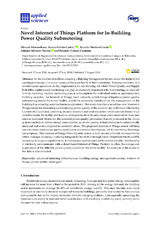Mostrar el registro sencillo del ítem
Novel Internet of Things Platform for In-Building Power Quality Submetering
| dc.contributor.author | Alonso-Rosa, Manuel | |
| dc.contributor.author | Gil-de-Castro, Aurora | |
| dc.contributor.author | Medina-Gracia, Ricardo | |
| dc.contributor.author | Moreno-Muñoz, A. | |
| dc.contributor.author | Cañete-Carmona, Eduardo | |
| dc.date.accessioned | 2018-10-02T07:19:33Z | |
| dc.date.available | 2018-10-02T07:19:33Z | |
| dc.date.issued | 2018 | |
| dc.identifier.uri | http://hdl.handle.net/10396/17203 | |
| dc.description.abstract | As the number of facilities adopting a Building Management System under the Industry 4.0 paradigm increases, it is critical to ensure the good health of their operations. Business continuity and uninterrupted operations are key requirements for any building, for which Power Quality and Supply Reliability sophisticated monitoring can play an extremely important role. Submetering, as opposed to bulk-metering, implies measuring power consumption for individual units or appliances in a building complex. An Internet of Things mesh network, which brings ubiquitous power quality submetering inside the entire facility, would be extremely beneficial for the management of the building thus ensuring seamless business operations. This work describes a novel low-cost Internet of Things sensor for measuring and analyzing power quality at the input of any individual Alternating Current (AC) appliance, providing an early detection and analysis system which controls those critical variables inside the facility and leads to anticipate faults with early-stage alerts based on on-time data streams treatment. Moreover, the recorded power quality parameters that are processed in the Cloud system can help to reduce energy consumption, as power quality disturbances can be automatically analyzed and even compared to standard values. The proposed Internet of Things sensor will help users to detect most power quality steady-state and events disturbances, while monitoring the energy consumption. This Internet of Things Power Quality sensor is built around a flexible microcontroller, which manages an energy metering Integrated Circuit (IC) through Serial Peripheral Interface (SPI), increasing its original capabilities by including new sophisticated software functionality. Additionally, it wirelessly communicates with a cloud-based Internet of Things Platform to allow the storage and supervision of the different power quality events for the entire facility. An example of the access to the data is also included. | es_ES |
| dc.format.mimetype | application/pdf | es_ES |
| dc.language.iso | eng | es_ES |
| dc.publisher | MDPI | es_ES |
| dc.rights | https://creativecommons.org/licenses/by/4.0/ | es_ES |
| dc.source | Applied Sciences 8,1320 (2018) | es_ES |
| dc.subject | Advanced metering infrastructure | es_ES |
| dc.subject | Building energy management system | es_ES |
| dc.subject | Internet of things | es_ES |
| dc.subject | Power quality | es_ES |
| dc.subject | Smart grid | es_ES |
| dc.title | Novel Internet of Things Platform for In-Building Power Quality Submetering | es_ES |
| dc.type | info:eu-repo/semantics/article | es_ES |
| dc.relation.publisherversion | http://dx.doi.org/10.3390/app8081320 | es_ES |
| dc.relation.projectID | Gobierno de España. TEC2016-77632-C3-2-R | es_ES |
| dc.rights.accessRights | info:eu-repo/semantics/openAccess | es_ES |

